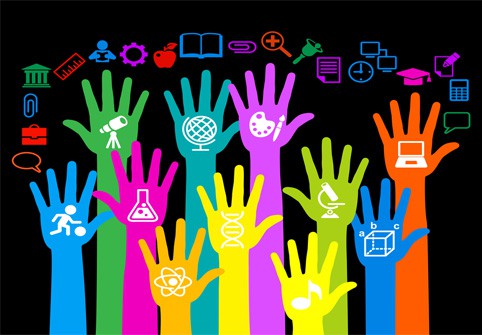Deeper Learning: Engaging Students Across the Humanities

Personalized math products are becoming more common in classrooms from kindergarten to college. These tools are really promising for building math skills and fluency. But I hear a growing number of people that compartmentalize learning technologies to skill building. Since raising my kids on Dr Brain, Oregon Trail, and Sim City, I’ve been convinced that technology can encourage students to think hard, persist through difficulty, to develop new mental models.
A local district leader says, “Learning happens through patterns and discourse.” Over the last few months I’ve seen technology tools that support this supposition by promoting collaboration and dialog, uncovering patterns in various disciplines, and promoting productive patterns of production.
The first product combines short videos of a smart college level dialog about a classic or modern text or work of fiction or nonfiction, a primary source document, or texts of history, social studies, or science situated within a social learning environment. StudySync is “online learning that inspires higher levels of reading, writing and critical thinking.” StudySync content is generated from reading lists from universities and aligned with Common Core State Standards and specifically reflecting the Common Core’s Performance Tasks. Teachers are able to consistently and continually monitor students and provide ongoing assessments using Sync-Lessons, Management and Assessment tools. Through SyncTV students are able to watch high quality videos of academic discourse, modeling college level for high-school product and high-school level for middle school, on a subjects across the humanities, helping to develop confidence and patterns of analysis.
“StudySync really helps the courses within the Humanities develop meaningful writings that are essential to the Literacy Standards mandated in the Common Core,” said Kathleen Miltz, an assistant high school principal near Indianapolis. She continued, “I definitely think that the features of StudySync boost critical thinking and writing.
“SyncTV episodes are great models for students to see how meaningful and productive discussions are held” Kathleen continued. “We assume students know how to talk about literature, because we provide them with questions, but to see students model and engage the way they do makes the process and expectation for group discussions more clear.“
Students are also encouraged to rate their peers and provide feedback through SyncReview. StudySync allows students to use social networking environments they are already comfortable with to enhance their learning experience. Kathleen said, “The writing prompts, Blasts and SyncTV all require students to be thinking and analyzing at a much higher level. They require students to dig deeper and go beyond basic understandings and plots.”
Heading in a similar direction, McGraw-Hill released Glencoe Writer’s Workspace, an online college prep reading and writing environment. “When we think about K-12 education and college and career readiness, there is perhaps no skill more important than writing,” said Stephen Mico, senior vice president of McGraw-Hill School Education’s Literacy and Humanities group. “New digital technology, such as real-time, online assessments, will push students to develop the foundational skills necessary to write skillfully—from a research paper to a letter of application.”
Students start with by reading a piece of literature and engaging in interactive responses. This prepares them for longer compositions. Both short and long form responses benefit from instant feedback and tools that guide them through the writing process.
Pearson’s Write to Learn is another online reading and writing environment that provides immediate and specific six-trait feedback to students. There are probably six essay scoring engines that provide very good feedback to students allowing teachers to assign more writing and get intelligent help with performance feedback.
Edmodo is a social learning platform that supports collaborative project-based learning. Liz Castillo, a 7th grade teacher in Honolulu uses Edmodo to create and assign “Interdisciplinary challenges that incorporated English, science, math, social studies, and health standards.”
To the extent that learning happens through patterns and discourse, emerging learning technologies are supporting good teaching across the curriculum. Computer simulations are building student understanding of complex social systems. Decision support tools are guiding post-secondary choices. Social learning platforms enable anytime collaboration with students anywhere on the planet.
Adaptive math products are great, but education technology isn’t just for basic skills anymore. Online collaborative environments are encouraging students to read, write, debate, and present their ideas across the curriculum. They are boosting critical thinking and college and career preparation.
This blog was first published on Huffington Post. Edmodo and StudySync are portfolio companies of Learn Capital where Tom is a partner and Pearson is an investor.







Tom Vander Ark
Just reviewed Big History, http://www.bighistoryproject.com/
It combines physics, cosmology, biology, geology, astronomy & a little sociology with story of how we got her. Still under construction but will be monster contribution (if high schools can figure out how to fit into master schedule).